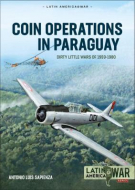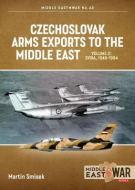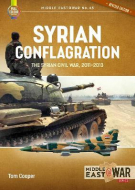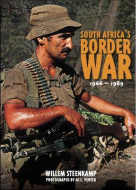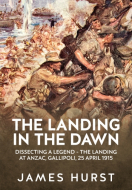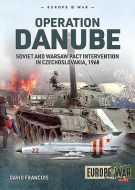
- Agriculture
- Architecture & Design
- Arts & Photography
- Biography
- Business
- Calendars and Diaries
- Childrens (All)
- Childrens (Illustrated)
- Childrens (Picture flats)
- Childrens (Te Reo)
- Classics
- Cooking, Food & Drink
- Craft & Hobbies
- Design (Art / Graphics)
- Design (Interiors)
- Education
- Fashion
- Fiction & Literature
- Fiction - Young Adult
- Gift Ideas
- Health & Wellbeing
- History
- Home & Garden
- Humour & Gift
- Instead of a Card Poems
- Military
- Music
- New Zealand
- NZ (History)
- NZ (Landscapes)
- NZ (Pictorial)
- Poetry
- Reference
- Religion & Faith
- Science & Nature
- Sport & Recreation
- Stationery
- Taschen : 40th Anniversary Edition
- Taschen : BA Basic Art
- Taschen : BU Bibliotheca Universalis
- Te Reo Māori
- Transport
- Travel
Helion & Company (181)
|
COIN Operations in Paraguay (Latin America@War 27)
ISBN: 9781915070746 Author: Antonio Sapienza Publisher: Helion & Company From 1954 Paraguay was held in the grip of a Right-wing dictatorship under General Alfredo Stroessner. In the years that followed, a number of opposition groups... From 1954 Paraguay was held in the grip of a Right-wing dictatorship under General Alfredo Stroessner. In the years that followed, a number of opposition groups resorted to armed struggle in order to achieve their aims. Government countermeasures were brutal, with torture and extra-judicial killings being routinely employed. COIN Operations in Paraguay is the first detailed English-language account of these armed opposition groups, their aims, their structures and their campaigns against the Stroessner government. It also details the ruthless government reaction and the support and opposition of other Latin American governments to the situation in Paraguay at this time. In addition to these conflicts within Paraguay, the 1980 assassination on Paraguayan soil of Anastasio Somoza Debayle, the exiled last dictator of Nicaragua, is examined in detail. COIN Operations in Paraguay includes over 190 photographs and 18 specially commission full-color artworks. Bind: paperback Pages: 72 Dimensions: 210 x 297 mm Publication Date: 22-03-2022 |
$49.99 |
|
|
Czechoslovak Arms Exports to the Middle East: Volume 2 (Middle East@War 44)
ISBN: 9781915070784 Author: Martin Smisek Publisher: Helion & Company During the Cold War, communist Czechoslovakia was one of the largest arms exporters to the Middle East among the Soviet Bloc countries. The second volume of thi... During the Cold War, communist Czechoslovakia was one of the largest arms exporters to the Middle East among the Soviet Bloc countries. The second volume of this mini-series describes the history of arms exports from Czechoslovakia to Egypt including related military assistance. Although Egypt had expressed interest in buying Czechoslovak arms just before the 1948 Arab-Israeli War, no deliveries were eventually made. The reason was the preferences of Prague, which fully supported Israel. The situation began to change from July 1950 when Czechoslovakia banned exports of its weapons to the Jewish country. These developments culminated in September 1955, when the first huge Czechoslovak-Egyptian arms deal was concluded. As a proxy of Moscow, Prague delivered impressive quantities of armament and ammunition together with spare parts, logistics, and support equipment. At the same time, Czechoslovak military instructors and advisors were sent to Egypt. A crucial role was played by a group of Czechoslovak Air Force personnel, whose task was to provide the tactical and combat training for two Egyptian fighter squadrons equipped with MiG-15bis jets prior to the Suez Crisis in 1956. At the same time, Egyptian military specialists were trained in the facilities of the Czechoslovak People's Army. However, from the end of the 1950s, there was a significant reduction in the supply of military hardware from Czechoslovakia because Prague was unwilling or unable to supply the state-of-the-art weapons required by the Egyptians. Bind: paperback Pages: 72 Dimensions: 210 x 297 mm Publication Date: 08-03-2022 |
$49.99 |
|
|
Syrian Conflagration: Revised Edition (Middle East@War 45)
ISBN: 9781915070814 Author: Tom Cooper Publisher: Helion & Company The Syrian Civil War experienced an entirely unexpected transformation during its first two years. It started as unrest and a series of mass demonstrations with... The Syrian Civil War experienced an entirely unexpected transformation during its first two years. It started as unrest and a series of mass demonstrations within the Syrian population in the context of wider protest movements in the Middle East and North Africa in 2011, known as the Arab Spring. Unlike events in Egypt, Libya, Tunisia and Yemen, where oppressive governments were toppled by the end of that year, the government of Syria deployed the full force of its military, its intelligence apparatus, and paramilitary groups, launching an unprecedented crackdown that resulted in the arrest, detention and killing of many thousands. Despite its brutality, this effort backfired: it provoked mass desertions of the Syrian military and then an armed uprising. The emerging insurgency was generally successful through 2012, although failing to capture Damascus, it secured more than half of Aleppo and Homs, the provincial capital of Raqqa, and nearly all of north-eastern and north-western Syria under its control. Although propped-up by economic and military support from the Islamic Republic of Iran and the Russian Federation, the government of Syria was nearing the brink of collapse during the first half of 2013 when, prompted by Tehran, Hezbollah - a Shi'a Islamic militant group and political party from Lebanon - entered the conflict on its side. Soon after, Hezbollah was reinforced by significant contingents of Iranian-sponsored Shi'a from Iraq, Lebanon and elsewhere, followed by volunteers from Iran, including crack units of the Islamic Revolutionary Guards Corps. Meanwhile, already split along the lines of Syria's complex demography, much of the insurgency transformed from a secular and non-sectarian movement into proxies of various foreign powers, foremost Saudi Arabia and Qatar, but also Turkey and Kuwait. Furthermore, foreign Jihadists motivated by al-Qaida joined the fray, aiming to establish an Islamist state and clandestinely cooperating with the government, they fell upon the insurgency. Bind: paperback Pages: 96 Dimensions: 210 x 297 mm Publication Date: 20-06-2022 |
$49.99 |
|
|
South Africa's Boarder War 1966-89
ISBN: 9781915113009 Authors: Al Venter, Willem Steenkamp Publisher: Helion & Company Of all the books about South Africa's 21-year 'Border War' - fought on both sides of Angola's frontier with present-day Namibia - South Africa's Border War has ... Of all the books about South Africa's 21-year 'Border War' - fought on both sides of Angola's frontier with present-day Namibia - South Africa's Border War has always been rated as among the best. A significant, full-color volume, it originally sold 31,000 copies in South Africa alone and has been out of print for decades. This version is the first re-issue of the original, written by Willem Steenkamp. Almost all the photos were taken by Al J. Venter who covered that conflict intermittently for almost two decades. Both Steenkamp and Venter have gone on to produce other works on that bitter conflict, but neither they nor anybody else has been able to match this beautiful coffee-table volume. Both agree that the book should be regarded as a tribute to a generation of fighting men, where sons often followed in the footsteps of their fathers, serving in the same units a generation apart. Though South Africa's 'Border War' started slowly with the first major clash of the conflict taking place on South West African soil at Omugulugwombashe in August 1966, hostilities escalated steadily, to the point where Moscow provided the Marxist Luanda government with all the military hardware it needed. Tens of thousands of Cuban troops were drafted into Angola after Portugal had abandoned its African territories. The conflict then entered several conventional phases that involved long-range South African armored strikes into Angola's interior and several major tank battles that eventually brought hostilities to an end. Luanda by then had already used chemical weapons on a limited scale and Pretoria was considering deploying its newly-developed nuclear arsenal. Willem Steenkamp, a seasoned war correspondent, covers all these historical issues in South Africa's Border War, as well as ancillary military strikes in several other black African countries that included Zambia and Mozambique. The book is exceptionally well illustrated, with hundreds of color as well as black-and-white photos; truly a valuable addition to recent African military history. Bind: paperback Pages: 256 Dimensions: 210 x 297 mm Publication Date: 29-04-2022 |
$79.99 |
|
|
A Legion Para in Algeria
ISBN: 9781915113726 Author: Peter Hoskins Publisher: Helion & Company Tony Hunter-Choat had a long and distinguished career in the British Army, including as CO of 23rd SAS Regiment. This book tells the story of his formative year... Tony Hunter-Choat had a long and distinguished career in the British Army, including as CO of 23rd SAS Regiment. This book tells the story of his formative years as a paratrooper with the elite 1st Foreign Parachute Regiment (1st REP) of the French Foreign Legion between 1957 and 1962 before he joined the British Army. In March 1957 the 21 years old Tony Hunter-Choat took the momentous decision to abandon his architectural studies which he was close to completing and join the Foreign Legion. He pawned his few possessions of value and used the proceeds to pay for his passage to Paris to enlist. In the training that followed he excelled and was selected for para training before joining the 1st REP, considered an elite unit not just in the Foreign Legion but throughout the French Army. Thus began an adventure which thrust him into the forefront of perhaps the most savage of post Second World War wars of decolonization and end of the European empires. He quickly proved his worth and became the youngest NCO in the Foreign Legion. In little more than two and a half years he had been promoted to Sergeant. The period of Tony's service saw him involved in ferocious combat; combat which resulted in three awards of the Croix de la Valeur Militaire, the Médaille Militaire and in due course appointment as Commander of the Légion d'Honneur - a singular achievement for a Briton. Tony served during a turbulent time for France, with the return to power of General de Gaulle in the face of the threat of a military coup d'état and the Generals' Putsch against de Gaulle in 1961. Tony was heavily involved in the Putsch with his regiment, which was disbanded as a consequence of its key role. The book is based on Tony's memoir. A memoir which is modest but paints a vivid picture of combat in the Algerian War, it also gives a most interesting, and at times amusing, insight into the values of the Legion and the everyday life of a legionnaire. As a French general said at Tony's memorial service it was during his life in the Legion that: '...through hardship and comradeship he learnt the hard way to be a man you can rely on: loyal, faithful, terrible to his enemies, generous to his friends.' Bind: paperback Pages: 190 Dimensions: 152 x 229 mm Publication Date: 20-10-2022 |
$55.00 |
|
|
The Fight For Life
ISBN: 9781804513255 Author: John Dixon Publisher: Helion & Company The Fight for Life: The Medical Services in the Gallipoli Campaign 1915–16 examines the development of the medical services immediately prior to the First Wor... The Fight for Life: The Medical Services in the Gallipoli Campaign 1915–16 examines the development of the medical services immediately prior to the First World War and its involvement in the failed Gallipoli Campaign. Although crucial to the entire operation, the planning for their involvement was both late and insufficient. In consequence, the services received considerable criticism both during and after the campaign. The Fight for Life explores the actual steps taken in the planning and the work carried out by the medical services at each stage of the campaign. Casualties sustained at the start of the Gallipoli operations were mainly combat-related but, as operations developed, there were a large number of sick caused by diseases such as dysentery and enteric fever. Much of this was related to poor sanitation, absence of water and the ever-present plague of flies. The causes of the diseases are examined and considered in light of the overall lack of success of the initial landings which prevented the routine development of sanitation, rest camps and base hospitals. The development of base hospitals is considered in respect to the increasing casualties arriving from the battlefield and the development of institutions in Egypt and later in Malta is considered in some detail. Early planning for such hospitals underestimated casualty figures and this was also a direct result of the lack of success during the first phase of the campaign. Further to this, the employment of hospital ships is explored together with the oft- criticised use of transports or ‘Black Ships’ for the same purpose. These vessels were a vital link in the treatment of the wounded and sick of the peninsula and in many cases they were forced to act as floating casualty clearing stations as their staff treated thousands, moving some to hospitals at both Lemnos and Imbros before sailing to base hospitals in Alexandria, Cairo or indeed Malta. The importance of nursing care aboard these ships is also considered, as nurses struggled to cope under adverse conditions. The harrowing winter 1915–16 storms are considered from the medical standpoint which added stress to a system working to cope with day-to-day casualties. The role played by the medical services in the evacuation of the peninsula is considered and the organization required for removal of casualties during the preparations cannot be overstated. Finally, a short analysis of the findings of the Dardanelles Commission as it applies to the medical services is provided. Bind: paperback Pages: 342 Dimensions: 170 x 245 mm Publication Date: 24-01-2024 |
$79.99DUE > 30th Jun 2024 |
|
|
Moscow's Game of Poker : Russian Military Intervention in Syria 2015-2017 (revised edition)
ISBN: 9781804510902 Author: Tom Cooper Publisher: Helion & Company In August 2015, the government of the Russian Federation embarked its military forces on an intervention in Syria. Ever since, there has been no end of discussi... In August 2015, the government of the Russian Federation embarked its military forces on an intervention in Syria. Ever since, there has been no end of discussion about Russian military capabilities and intentions – in Syria and beyond. To many, the performance of the Russian military – and especially the Russian Air-Space Force (VKS) – in this war was a clear demonstration of advanced technology, improved training, fearsome firepower, and great mobility. To others, the military operation only experienced limited success and exposed a number of weaknesses. Prominent amongst the latter were aircraft ill-suited to the necessities of expeditionary warfare, and a gross lack of advanced weaponry and equipment. While the military component of their intervention can only be described as having provided clear evidence that the Russian military was in no condition to directly challenge NATO’s eastern frontiers, it cannot be denied that through this action Moscow effected a turning point in the Syrian Civil War, and indeed one on a geostrategic level. Organised and conducted in cooperation with very diverse allies – ranging from the Islamic Revolutionary Guards Corps of Iran (IRGC), Hezbollah of Lebanon, the Kurdistan Workers Party (PKK) and a myriad of local warlords and their armed militias – through the combination of intentional bombardment of insurgent-controlled parts of Syria, and indirect protection for the IRGC’s own military intervention in the country from a possible counter-intervention of the West, the Russians succeeded in saving the regime of the Syrian President Bashar al-Assad. Moscow’s Game of Poker provides a unique overview and analysis of Moscow’s political aims, strategy, doctrine, target selection process, military technology and tactics, day-by-day operations, and the way the Russian Federation cooperated with local allies. This story is told in combination with exclusive insight into the similar campaign run by what was left of the Syrian Arab Air Force. This revised edition of Moscow’s Game of Poker includes over 130 full colour photographs, maps and specially commissioned colour artworks of vehicles, aircraft and combatants. Bind: paperback Pages: 96 Dimensions: 210 x 297 mm Publication Date: 30-06-2022 |
$55.00 |
|
|
1805 - Tsar Alexander's First War With Napoleon
ISBN: 9781915113856 Author: Alexander Ivanovich Mikhailovsky-Danilevsky Publisher: Helion & Company The official history of the first war between Tsar Alexander I and Napoleon in 1805, using original military and diplomatic documents and the testimonies of wit... The official history of the first war between Tsar Alexander I and Napoleon in 1805, using original military and diplomatic documents and the testimonies of witnesses and participants from the war. First published in 1844, the history describes the causes of the war and the state of the opposing armies before tracking the march of Kutusov's corps into Austrian territory and the concurrent Austrian disaster at Ulm. It then looks at the Tsar's diplomatic efforts: Emperor Alexander's journey abroad; Prussia's changing relationship with Napoleon; the Treaty of Potsdam; and the Tsar's relations with Britain and Sweden. Returning to the Danube theater the history covers: Kutuzov's retreat from Braunau to Krems, the actions at Lambach and Amstetten, the Battles of Krems and Dürnstein; Kutuzov's march from Braunau to Znaim; Bagration's march to Hollabrun; and the action at Schöngrabern. After a consideration of operations in the Tyrol and Italy, the narrative shifts to the arrival of Buxhoeveden's corps and the Austerlitz campaign including the action at Wischau and the pre-battle maneuvering and dispositions. Austerlitz itself is then considered in detail: Napoleon's dispositions; initial operations by Dokhturov, Langeron and Przhibyshevsky; the defeat of the coalition center; Kamensky's battle; the exploits of Prince Volkonsky; the actions of the coalition cavalry; the defeat of the Russian Guard; Bagration's operations; the defeat of Langeron and Przhibyshevsky; Dokhturov's exploits; the coalition withdrawal; casualties of the coalition and French armies. The narrative of the primary theater of war concludes with the arrival of Essen's corps, the Tsar's return to Russia, the Peace of Pressburg, and the march of the Russians through Hungary and Galicia. However, details are also included of subsidiary operations in Hanover under Tolstoy in conjunction with the British and Swedes, and in the Mediterranean under Lacy at Naples and Corfu. Bind: paperback Pages: 156 Dimensions: 152 x 229 mm Publication Date: 15-10-2022 |
$69.99 |
|
|
The Landing In The Dawn
ISBN: 9781804514764 Author: James Hurst Publisher: Helion & Company The Gallipoli Landing of 25 April 1915 is arguably Australia’s best known battle. It is commemorated each year with a national holiday, services, parades and ... The Gallipoli Landing of 25 April 1915 is arguably Australia’s best known battle. It is commemorated each year with a national holiday, services, parades and great media attention. 2015, the centenary of the Gallipoli Campaign, was marked by great publicity and the release of many books, articles, films, documentaries and television series. Despite this attention, the Landing is still a poorly understood battle, with the historiography coloured by a century of misinformation, assumption, folklore and legend. The Landing in the Dawn: Dissecting a Legend - The Landing at Anzac, Gallipoli, 25 April 1915, re-examines and reconstructs the Anzac Landing by applying a new approach to an old topic – it uses the aggregate experience of a single, first-wave battalion over a single day, primarily through the investigation of veteran’s letters and diaries, to create a body of evidence with which to construct a history of the battle. This approach might be expected to shed light on these men’s experiences only, but their accounts surprisingly divulge sufficient detail to allow an unprecedented reconstruction and re-examination of the battle. Thus it effectively places much of the battlefield under a microscope. The use of veterans’ accounts to re-tell the story of the Landing is not new. Anecdotes have for many years been layered over the known history, established in C.E.W. Bean, Official History of Australia in the War: The Story of ANZAC, Volume I, as the standard existing narrative. Here, detail extracted from an unprecedented range of primary and secondary sources, is used to reconstruct the history of the day, elevating participants’ accounts from anecdote to eye-witness testimony. This shift in the way evidence is used to reinterpret the day, rather than simply painting it into the existing canvas, changes the way the battle is perceived. Even though more than 100 years have passed since the Landing, and well over 1,000 books have been written about the campaign, much can be learned by returning to the “primary source, the soldier.” The Landing has not been previously studied at this level of detail. This work complements Bean’s by providing new evidence and digging deeper than Bean had the opportunity to do. It potentially re-writes the history of the Landing. This is not an exclusive Australian story – for example, one third of the battalion examined were born in the British Isles. This volume, the most current and comprehensive study since Bean’s, has been rightly described as a major contribution that will change the way the legendary amphibious operation is viewed. Bind: paperback Pages: 264 Dimensions: 170 x 245 mm Publication Date: 12-01-2024 |
$79.99DUE > 30th Jun 2024 |
|
|
Operation Danube (Europe@War 7)
ISBN: 9781913336295 Author: David Francois Publisher: Helion & Company On 20 August 1968, hundreds of thousands of soldiers, dozens of thousands of tanks and armored vehicles, and hundreds of military aircraft of the Warsaw Pact ar... On 20 August 1968, hundreds of thousands of soldiers, dozens of thousands of tanks and armored vehicles, and hundreds of military aircraft of the Warsaw Pact armed forces invaded Czechoslovakia in an operation code-named Danube. It was the largest military undertaking in Europe since 1945. Starting with a description of the history of Czechoslovakia, especially after the communist takeover of power in 1948, this volume describes the birth and development of the Prague Spring in 1968 and an attempt to reform the communist system from within. It recounts the hostility this process encountered on the part of the Union of Soviet Socialist Republics (USSR/Soviet Union), and its allies within the Warsaw Pact, and provoked a split in the Kremlin about solutions for the resulting 'Czechoslovak problem'. The crisis that developed throughout the spring and summer of 1968 led to the military intervention. While paying special attention to the military and strategic aspects of the Czechoslovak crisis, this volume also provides a blow-by-blow account of its impacts upon the Czechoslovak armed forces and the Warsaw Pact. The subsequent military operation - codenamed Operation Danube - is described in all of its components, including the airborne and ground aspects, and the political operation that supported it. Within only 24 hours, the Soviet and Warsaw Pact forces secured the entire territory of Czechoslovakia, de-facto overrunning the local armed forces in the process. The Czechoslovak population organized nonviolent resistance, thus highlighting the political aspects of the intervention. However, it was hopelessly out of condition to prevent the ultimate downfall of the so-called 'Prague Spring', and the related hopes. Bind: paperback Pages: 72 Dimensions: 210 x 297 mm Publication Date: 23-11-2020 |
$49.99 |


